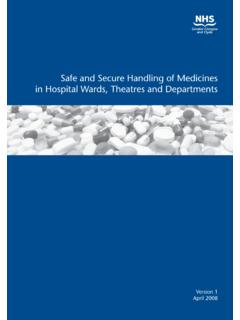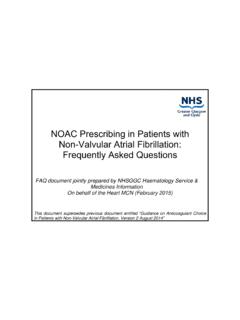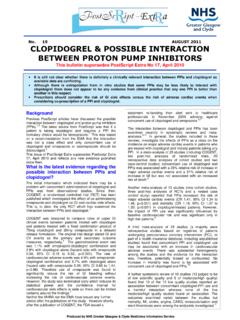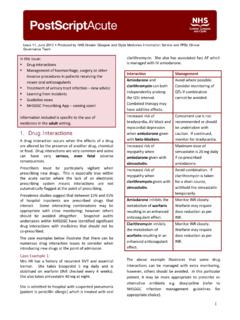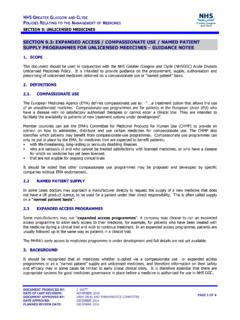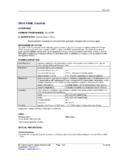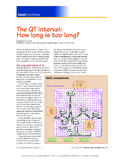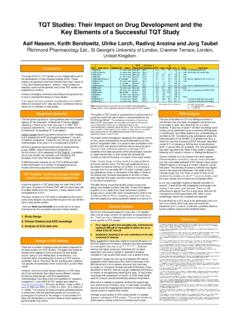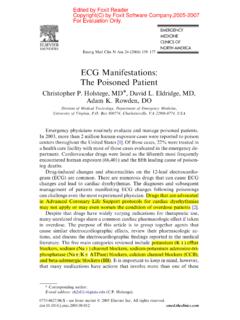Transcription of DRUG INDUCED QT PROLONGATION - GGC …
1 Issue 21, December 2012 Produced by NHS Greater Glasgow and Clyde Medicines Information Service drug INDUCED QT PROLONGATION PROLONGATION of the QT interval can lead to a life threatening arrhythmia known as torsades de pointes Recent warnings have highlighted the risk of QT PROLONGATION with citalopram, domperidone and ondansetron Extra vigilance is required by healthcare professionals to be alert to the risk of drug INDUCED QT PROLONGATION and drug interactions PROLONGATION of the QT interval can lead to a life threatening ventricular arrhythmia known as torsades de pointes which can result in sudden cardiac death.
2 There are a number of widely used drugs which are known to cause QT PROLONGATION . Recently there have been warnings relating to drug - INDUCED QT PROLONGATION for three commonly used drugs citalopram, domperidone and ,2,3 Extra vigilance is required by healthcare professionals to be alert to the risk of drug INDUCED QT PROLONGATION and drug interactions. There are three mechanisms by which drugs can interact and increase the risk of QT PROLONGATION : Pharmacodynamic Interaction: The concurrent use of more than one drug that prolongs the QT interval increases the risk of torsades de pointes and ventricular arrhythmia.
3 Pharmacokinetic Interaction: Some drugs which do not prolong the QT interval themselves can increase the risk of QT PROLONGATION by affecting the metabolism of drugs that do. Commonly used examples of this include drugs such as macrolide antibiotics and antifungals which inhibit the CYP3A4 enzyme. Effects on Electrolytes: Hypokalaemia and hypomagnesaemia can increase the risk of QT PROLONGATION diuretics can interact with QT prolonging drugs by causing hypokalaemia. What is a normal QT interval?
4 The QT interval varies with heart rate. A number of formulas are used to correct the QT interval for heart rate. Once corrected it is expressed as the QTc interval. The QTc interval is reported on the ECG printout. Normal QTc Interval <440 ms What is considered to be a prolonged QT interval? The QTc interval is a surrogate marker of proarrhythmic risk and literature differs with regard to the QTc interval that would raise concern over development of arrhythmias. As a guide: Borderline QTc interval >440 ms but <500 ms Although literature differs, a QTc interval within these values is considered borderline prolonged.
5 Consideration should be given to dose reduction of QT prolonging drugs or changing to an alternative non QT prolonging drug . Prolonged QTc Interval >500 ms A QTc interval >500 ms is clinically significant and likely to confer an increased risk of arrhythmia. Any drugs which prolong the QT interval should be reviewed immediately. 4,5,6,7 Interpretation of the QT interval on an ECG is not always straightforward and the value noted on the computerised printout may not always be accurate. The following website gives some guidance on interpretation of the QT interval: What is considered a significant drug INDUCED change in QTc interval?
6 The degree by which a drug changes the QTc interval from baseline is also important. An increase in baseline QTc of less than 5 ms is not considered significant and this is the threshold for regulatory concern. For drugs that increase the QTc interval by less than 20 ms the data is inconclusive with regard to arrhythmic risk. A change in baseline QTc of >20 ms should raise concern and a change of >60 ms should raise greater concern regarding the potential for Experience in long QT syndrome indicates that for every 10 ms increase in QTc there is a 5% increase in the risk of arrhythmic drug INDUCED QT PROLONGATION is often dose related.
7 For example, citalopram 20 mg daily has been shown to cause a mean change in baseline QTc of ms; this increases to ms with citalopram 60 mg A drug INDUCED increase in QTc interval should be assessed in conjunction with the overall QTc interval. Page 1 A list of medicines known to prolong the QT interval can be found at Produced by NHS Greater Glasgow and Clyde Medicines Information Service What are the risk factors for QT PROLONGATION ? In individual cases of torsades de pointes there are often multiple risk factors present.
8 The main risk factors which should be considered are:8,9,10,11 Potentially Modifiable Electrolyte Disturbances (in particular hypokalaemia, hypomagnesaemia and more rarely hypocalcaemia). Consider the risk of electrolyte disturbance if the patient has GI upset Bradycardia Concomitant use of more than one drug that prolongs the QT interval Non-modifiable Congenital Long QT Syndrome Cardiac Disease (of multiple origins, including congestive heart failure, ventricular hypertrophy, recent conversion from AF) Impaired hepatic/renal function (due to effects on drug metabolism) Thyroid Disease (more common with hypothyroidism and usually normalises with treatment)
9 Female Sex Age over 65 years What medications can cause QT PROLONGATION ? It is not possible to include a full list of all medicines known to increase the QT interval in this bulletin. A list of medications known to prolong the QT interval can be found at This website categorises drugs based on their risk. It is recommended that you check the lists for drugs commonly used in your area of practice to familiarise yourself with the risks. Some of the more commonly encountered drugs that are known to prolong the QT interval are listed in table 1.
10 Antimicrobials Antipsychotics (all have some risk) Erythromycin Risperidone Clarithromycin Fluphenazine Moxifloxacin Haloperidol Fluconazole Pimozide Ketoconazole Chlorpromazine Antiarrhythmics Quetiapine Dronedarone Clozapine Sotalol Antidepressants Quinidine Citalopram/escitalopram Amiodarone Amitriptyline Flecainide Clomipramine Dosulepin Others Doxepin Methadone Imipramine Protein kinase inhibitors sunitinib Lofepramine Some antimalarials Antiemetics Some antiretrovirals Domperidone Telaprevir Droperidol Boceprevir Ondansetron/Granisetron Table 1: Drugs that can prolong the QT interval.
